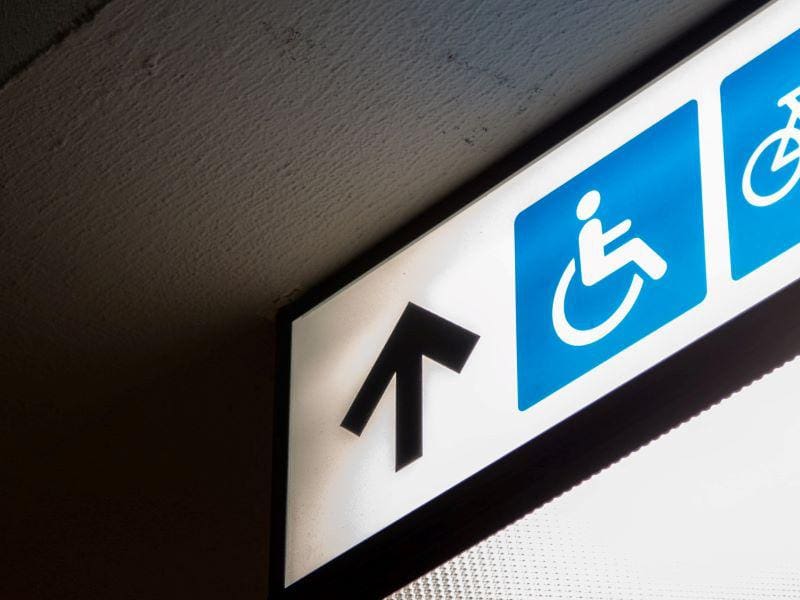Essential Elements of ADA Signs

Proper signage is essential for a customer-friendly atmosphere. Restaurants, hotels, retail stores, grocery stores, office buildings, and more will benefit from providing information to guests in a coherent and attractive fashion.
And ADA signs are one of the most important signage considerations a business can make.
This refers to rules and regulations stemming from the Americans with Disabilities Act (ADA) of 1990. This important piece of legislation covers a lot of ground, but in short, it prohibits the discrimination of a person based on their disability.
The ADA has wide-ranging implications for many industries such as public transportation, hospitality businesses, and guidelines for employers.
ADA signs are one of the most basic considerations a business has to take in order to keep the needs of those that fall under the protection of the ADA in mind.
Here’s what your business needs to know about ADA signs, how to implement them into your business, and where to find them.
Placement on the Wall
The height at which a sign should be hung needs to align with ADA requirements. This height is not measured by the border of the sign itself, but by the words included within the sign.
The highest copy in the sign should not exceed 60 inches from the ground. This refers to the top of the highest letters on the sign.
The lower limit for height is measured from the bottom of the lowest letters, and should not fall below 48 inches.
Measuring from the text on the sign as opposed to the outside of the sign itself ensures the important information will fall within a predetermined range no matter what the actual size of the sign may be.
In Relation to the Door
ADA signs should be mounted near the latch of the door. However, different situations can create different placements.
Double doors should have the sign mounted to the right of the doors. If one of these doors doesn’t open, the sign should be mounted near the immovable side.
The sign may be mounted on the door itself if it swings inward as long as it either closes automatically, is mounted near the push side of the door, or does not have a door stop. Common examples of this are bathroom doors and kitchen doors.
Visit Identity Group and learn more about our options for ADA signs!
Size Requirements
The text on a sign must meet certain requirements to improve visibility, such as a minimum height of ⅝ inch, up to two inches. However, a minimum two-inch height per line of text is required no matter the size of text. Larger text must incorporate twice the space per line of text.
Each line of braille needs to be at least one inch high.
Content Requirements
ADA signs must be constructed with the goal of being easy to read. The size of the font is one consideration that addresses this issue. The type of font also helps make your sign easier to read for people with sight issues.
The fonts used within ADA signs must be a sans serif font with a medium or bold weight. This includes:
- Arial
- AvantGarde
- Calibri
- Helvetica
- Verdana
- And more
Also, all ADA signs should utilize capital letters. Consistency between signs helps people with vision problems read the sign more easiliy.
Pictograms are also often used and must be at least six inches tall.
Types of ADA Signs
There are a wide variety of ADA signs. Any instructional sign in your establishment should have an accompanying ADA sign or fit ADA requirements itself. Here are a few examples of required ADA signs:
- Exit Signs
- Wheelchair Accessible Signs
- Restroom Signs
- Elevator Signs
- No Smoking Signs
- Stairway Signs
- ‘In Case of Fire Use Stairs’ Sign
Who Needs to Provide ADA Signs?
According to the 2010 ADA Standards for Accessible Design:
“Each facility or part of a facility constructed by, on behalf of, or for the use of a public entity shall be designed and constructed in such manner that the facility or part of the facility is readily accessible to and usable by individuals with disabilities, if the construction was commenced after January 26, 1992.”
There are exceptions for buildings that can prove structural impracticality of adhering to ADA standards, but that mostly relates to physical considerations. Signs are going to be required in just about every building that is open to members of the public.
Do you have a need for expertly-crafted ADA signs? Identity Group provides a variety of finishes and styles to make sure your ADA-compliant signs fit your atmosphere while also providing the necessary guidance.
